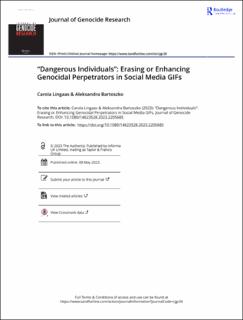| dc.contributor.author | Bartoszko, Aleksandra | |
| dc.date.accessioned | 2023-05-10T14:00:48Z | |
| dc.date.available | 2023-05-10T14:00:48Z | |
| dc.date.created | 2023-05-08T14:27:41Z | |
| dc.date.issued | 2023 | |
| dc.identifier.issn | 1462-3528 | |
| dc.identifier.issn | 1469-9494 | |
| dc.identifier.uri | https://hdl.handle.net/11250/3067527 | |
| dc.description.abstract | What role do user-generated GIFs (Graphics Interchange Format) have in social media and how do they contribute to distorted representations of genocides? This article analyses the availability of GIFs in Facebook Messenger in light of Facebook’s own Community Standards that prohibit the sharing of content with references to “dangerous individuals.” The company explicitly proscribes the representation of perpetrator(s) of multiple-victim violence. This article examines the narrative power of GIFs related to the Holocaust, the former Yugoslavia, and the Khmer Rouge regime in Cambodia and the representation of political and military leaders. Our systematic search documents a selective execution of the Community Standards as well as selective censorship of génocidaires. Rather than analysing how users create and Facebook manages these GIFs, we take this observation as a troubling indication of selective portrayal of historical truths. By making some perpetrators hypervisible, GIFs privilege certain narratives, while simultaneously muting the crimes and victims. While much attention has been given to social media’s power to (mis)represent and (re)create truths about ongoing conflicts, less attention has been given to the representation of past conflicts. Few studies examine the role of GIFs in the representation of historical figures. Drawing on memory studies and studies of historical and social representation, this article contributes to filling this gap. It argues that Facebook creates and reproduces a distorted understanding of “dangerous individual.” GIFs depicting convicted perpetrators of genocide are especially problematic given current strong trends of denialism and revisionism in countries like Serbia. | en_US |
| dc.language.iso | eng | en_US |
| dc.publisher | Routledge | en_US |
| dc.relation.ispartofseries | Journal of Genocide Research; | |
| dc.rights | Navngivelse 4.0 Internasjonal | * |
| dc.rights.uri | http://creativecommons.org/licenses/by/4.0/deed.no | * |
| dc.title | “Dangerous Individuals”: Erasing or Enhancing Genocidal Perpetrators in Social Media GIFs | en_US |
| dc.type | Peer reviewed | en_US |
| dc.type | Journal article | en_US |
| dc.description.version | publishedVersion | en_US |
| cristin.ispublished | true | |
| cristin.fulltext | original | |
| cristin.qualitycode | 1 | |
| dc.identifier.doi | http://dx.doi.org/10.1080/14623528.2023.2205685 | |
| dc.identifier.cristin | 2146190 | |
| dc.source.journal | Journal of Genocide Research | en_US |

